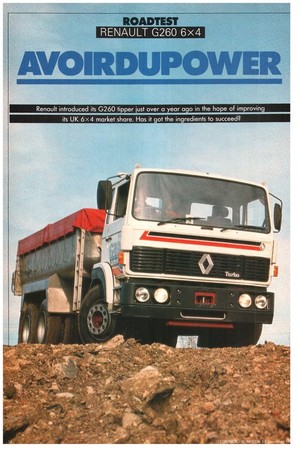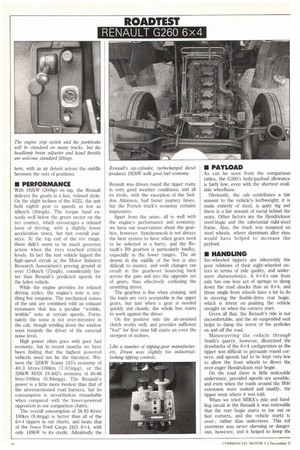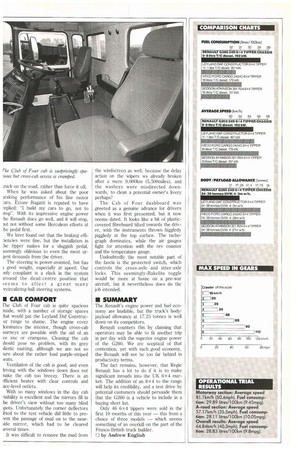AVOIRDUPOWER
Page 74

Page 75

Page 76

Page 77

If you've noticed an error in this article please click here to report it so we can fix it.
Renault introduced its G260 tip•er just over a year a•o in the hope of improving
its UK 6x4 market share. Has it sot the in•redients to succeed? • Towards the end of the last Wilson government, when the late John Stonehouse (or was it Reggie Perrin?) was preparing for his impromptu dip into the Atlantic and notoriety, Commercial Motor steadfastly reported on the Club of Four Consortium's "light truck" and, more specifically, the cab (CM 17 January 1975).
The British public probably took scant notice of the new range of vehicles from the Consortium — Daf, KlocknerHumboldt-Deutz (Magirus), Saviem and Volvo. Public tastes wax and wane however and, while Glam Rock and the Cab of Four are inexorably associated with the year of 1975, only one of them survives today.
The Club of Four cab has advanced since its early spartan days, and worn more badges than a Beastie Boys fan. In its latest form, atop the frame of Renault's newly-available G260 6x4 tipper, it is plusher within. Its exterior now sports a pair of smart, but totally useless, corner deflectors and two cab-top marker lamps.
The Renault G260 joins two Commando-based Perkins-engined 6x4 Renault tippers: the range will eventually include the G290 8x4 shown at this year's Motor Show.
Renault must be hoping to increase its lowly market share with these vehicles, particularly in the 6x4 market. Although it has its ancestry in the French, rather than British, side of the RTI family, the 6x4 G260 is a British development and, like its newer G290 8x4 sister, is built only in Britain.
Traditionally dominated by Leyland, the market for 6x4 tippers was 17% up between January and October over the same period last year. There are five major players in this market, and their shares between January and October were: Leyland Daf (37.6%); Volvo (14.2%); Iveco Ford (12.8%); Mercedes-Benz (11.7%); and Seddon Atkinson (9.7%). Renault, selling only 46 6x4s, had a 1.6% share.
To call a lorry "premium" when it uses a 13-year-old cab design may seem a little optimistic, but the Renault six-legger has only been on the market for just over a year, and supplies were a bit slow at first. The cab looks dated, but Renault still uses it for the G range of tractive units, rigids and tippers. It comes with a sleeper cab extension, and even the "GT" high roof on the Renault G290 models.
• DRIVELINE
Renault's MIDR 06045 engine is one of a family of six-cylinder blown diesels that are fitted to the G series.
The power ratings run from 126kW to around 214kW, which means the G260's engine is at the top end of the range with its 192kW. The gearbox is the Renault B9 unit, which has eight forward speeds and one crawler. The shift is double "H" pat tern, with an air detent across the middle between the sets of positions.
• PERFORMANCE
With 192kW (260hp) on tap, the Renault delivers the goods in a fast, relaxed style. On the slight inclines of the A222, the unit held eighth gear to speeds as low as 48km/h (30mph). The torque band extends well below the green sector on the rev counter, which encourages a relaxed form of driving, with a slightly lower acceleration times, but fast overall journeys. At the top end of the rev range, there didn't seem to be much governor action when the revs reached critical levels. In fact the test vehicle lapped the high-speed circuit at the Motor Industry Research Association's proving ground at over 114km/h (71rnph), considerably faster than Renault's predicted speeds for the laden vehicle.
While the engine provides for relaxed driving styles, the engine's note is anything but sanguine. The mechanical noises of the unit are combined with an exhaust resonance that has a peculiar "wobble, wobble" note at certain speeds. Fortunately the noise is not over-intrusive in the cab, though winding down the window soon reminds the driver of the external noise level.
High power often goes with poor fuel economy, but in recent months we have been finding that the highest powered vehicels need not be the thirstiest. Witness the 320kW Scalia 143's economy of 40.3 litres/100km (7.01mpg), or the 338kW MAN 19.462's economy of 40.66 litre/100km (6.94mpg). The Renault's power is a little more modest than that of the aforementioned road burners, but its consumption is nevertheless remarkable when compared with the lower-powered opposition in our comparison charts.
The overall consumption of 28.83 litres/ 100km (9.8mpg) is better than all of the 6x4 tippers in our charts, and beats that of the lveco Ford Cargo 2421 6x4, with only 149kW to its credit. Admittedly the Renault was driven round the tipper route in very good weather conditions, and all its rivals, with the exception of the Seddon Atkinson, had faster journey times, but the French truck's economy remains impressive.
Apart from the noise, all is well with the engine's performance and economy: we have our reservations about the gearbox, however. Synchromesh is not always the best system to have when gears need to be selected in a hurry, and the Renault's B9 gearbox is particularly baulky, especially in the lower ranges. The air detent in the middle of the box is also difficult to master, and swift changes can result in the gearlever bouncing back across the gate and into the opposite set of gears, thus effectively confusing the unwitting driver.
The gearbox is fine when cruising, and the loads are very acceptable in the upper gears, but just when a gear is needed quickly and cleanly, the whole box starts to work against the driver.
On the positive side the air-assisted clutch works well, and provides sufficient "feel" for first time hill starts on even the steepest of inclines.
• PAYLOAD
As can be seen from the comparison tables, the G260's body/payload allowance is fairly low, even with the shortest available wheelbase.
Obviously, the cab contributes a fair amount to the vehicle's kerbweight; it is made entirely of steel, is quite big and there is a fair amount of metal behind the seats. Other factors are the Hendrickson steel-bogie and the substantial mild-steel frame. Also, the truck was mounted on steel wheels, where aluminium alloy rims would have helped to increase the payload.
III HANDLING
Six-wheeled tippers are inherently the poor relations of their eight-wheeled sisters in terms of ride quality, and understeer characteristics. A 6x4's one front axle has one less set of springs to damp down the road shocks than an 8x4, and those single front wheels have a lot to do in steering the double-drive rear bogie, which is intent on pushing the vehicle straight on when the corners start.
Given all that, the Renault's ride is not uncomfortable, and the air-suspended seat helps to damp the worst of the potholes on and off the road.
Manoeuvring the vehicle through Smith's quarry, however, illustrated the drawbacks of the 6X4 configuration as the tipper was difficult to persuade round corners, and speeds had to be kept very low to allow the front wheels to direct the over-eager Hendrickson rear bogie.
On the road there is little noticeable understeer, provided speeds are sensible, and even when the roads around the M40 extension were soaked and muddy, the tipper went where it was told.
When we tried MIRA's ride and handling circuit in the Renault it was noticeable that the rear bogie starts to toe out on fast corners, and the vehicle starts tc over-, rather than uridersteer. This roll oversteer was never alarming or dangerous, however, and it helped to keep the :ruck on the road, rather than force it off.
When he was asked about the poor )raking performance of his fine motor :ars, Ettore Bugatti is reputed to have 7eplied: "1 build my cars to go, not to ;top". With its impressive engine power he Renault does go well, and it will stop, )ut not without some Herculean efforts at he pedal first.
We later found out that the braking effi:iencies were fine, but the installation in :he tipper makes for a sluggish pedal, ieemingly oblivious to even the most urgent demands from the driver.
The steering is power-assisted, but has good weight, especially at speed. Our mly complaint is a slack in the system iround the dead-centre position that 3eems to affect a great many vcirculating-ball steering systems.
• CAB COMFORT
Die Club of Four cab is quite spacious nside, with a number of storage spaces hat would put the Leyland Oaf Construc,or range to shame. The engine cover lominates the interior, though cross-cab ourneys are possible with the aid of an ce axe or crampons. Cleaning the cab ;hould pose no problem, with its grey )Iastic matting, although we are not so ;ure about the rather loud purple-striped ;eats.
Ventilation of the cab is good, and even iriving with the windows down does not nake the cab too breezy. There is an !fficient heater with clear controls and ace-level outlets.
With so many windows in the day cab risibility is excellent and the mirrors fill in he driver's view without too many blind ;pots. Unfortunately the corner deflectors itted to the test vehicle did little to preient the passage of mud on to the neardde mirror, which had to be cleared ;everal times.
It was difficult to remove the mud from the windscreen as well, because the delay action on the wipers ws already broken after a mere 9,000km (5,500miles), and the washers were misdirected downwards, to clean a potential owner's livery perhaps?
The Cab of Four dashboard was greeted as a genuine advance for drivers when it was first presented, but it now seems dated. It looks like a bit of plasticcovered fibreboard tilted towards the driver, with the instruments thrown higgledy piggledy at the top surface. The tachograph dominates, while the air gauges fight for attention with the rev counter and the temperature gauge.
Undoubtedly the most notable part of the fascia is the protected switch, which controls the cross-axle and inter-axle locks. This seemingly-Bakelite toggle would be more at home on a pre-war aircraft, but it nevertheless does do the job intended.
• SUMMARY
The Renault's engine power and fuel economy are laudable, but the truck's body/ payload allowance at 17.25 tonnes is well down on its competitors.
Renault counters this by claiming that operators may be able to fit another trip in per day with the superior engine power of the G260. We are sceptical of that contention, yet with such good economy, the Renault will not be too far behind in productivity terms.
The fact remains, however, that Regie Renault has a lot to do if it is to make significant inroads into the UK 6x4 market. The addition of an 8x4 to the range will help its credibility, and a test drive by potential customers should persuade them that the G260 is a vehicle to include in a buying short list.
Only 46 6x4 tippers were sold in the first 10 months of this year — this from a choice of three models — which seems something of an overkill on the part of the Franco-British truck builder.
0 by Andrew English














































































